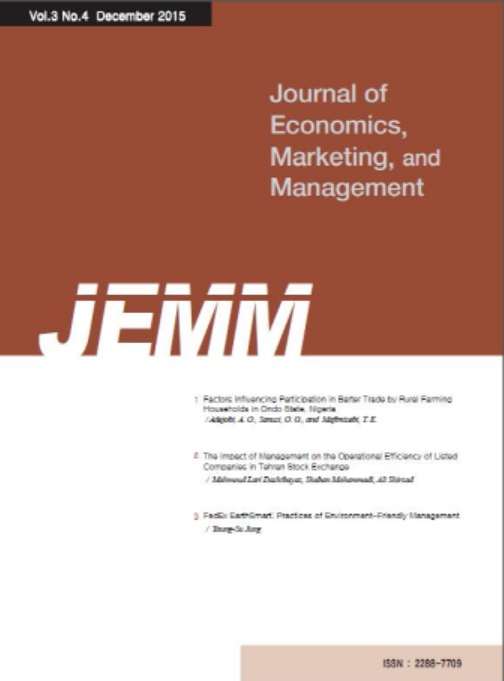7권 1호
초록
Abstract
Purpose - Currently, the economic globalization has become a common channel for China's enterprise to perform the international economic activities. Due to this background, this paper tries to analyze the influence of internationalization level on operation performance of enterprises. Research design, data, and Methodology - This paper aims at 296 companies going listed in Shanghai Stock Exchange and Shenzhen Stock Exchange. The data about the listed companies during the 12 years from 2005 to 2016 have been collected. Relevant theories, including the theory of comparative advantage, monopolistic advantage and product life cycle in developed countries as well as the small scale technology and state on localized technological capacities in developing countries, have been summarized to provide theoretical basis for the influence of international operation on operation performance of the enterprises. Moreover, the current status of international operation of China's enterprises, including the dynamic cause of the internationalization of China's enterprises, its competitive advantage and disadvantage as well as the interest and potential risk of the internationalization, have been also analyzed. Results - Via adopting the panel data to conduct an empirical analysis, It can be found that the relationship between international operation level and operation performance of China's enterprises can be expressed as the S-curve of declining, rising and declining again. Conclusions - This paper has taken the lead in using Ohlson corporate value model to fill the gap in the relevant researches in China. It can also provide guidance for the international operation of China's enterprises. Meanwhile, the two systems for international operation and performance evaluation index have been put forward. The performance of international operation can be classified as financial performance or corporate value so that the operation effect of those China's enterprises going abroad can be better evaluated.
초록
Abstract
Purpose - This paper attempts to derive effective performance-reward strategies for SMEs to raise the valence for their employees while using their relatively limited resources, which is one of the primary concerns raised by SME CEOs. Research design, data, and methodology - This paper draws on the four question items such as the financial/direct factors, the financial/indirect factors, the non-financial/direct factors and the non-financial/indirect performance-reward factors to shed light on the most important factors and aspects that need improving, using the AHP and IPA. Results - The overall findings on the SMEs' performance-reward factors of interest here are indicative of the need for rectifying their performance-reward systems. Conclusions - SMEs' performance-reward factors of interest here are indicative of the need for rectifying their performance-reward systems. In particular, despite the fact that SMEs can hardly offer high wages or bonuses as large enterprises do, the expectancy theory suggests it is better to reward employees as per a valid common system, while the equity theory underscores the need to maintain and reinforce the fairness in distribution, procedures and interactions.
초록
Abstract
Purpose - This paper is to review recent literature, by conducting a thorough investigation of the limitations and implications for future research on work-life balance with the focus and linkages between work-life balance practices, machine learning and emotional intelligence, work-life conflict, the correlations between work-life enrichment and work-life balance practices, the relationships between employee job satisfaction and work-life balance, the links between work-life balance and the managerial support. Research design, data, and methodology - The paper will further detail linkages between work-life balance and organizational performance outcomes productivity and innovation. Previous literatures have paid attentions to the link of HR practices and organizational outcomes such as productivity, flexibility, and financial performance, but the understanding needs to be extended to involve innovation performance. Dealing with employees' emotions using different machine learning techniques is one of the phenomenal researches in today's world. Here, we examine how far the employees are conscious of their own self and found the ideas and views of an individual about themselves and others. Without proper knowledge about their personality it will be very difficult for an individual to manage their own emotions. This study also aims at finding out the individual abilities to manage their emotions in order to perform well. Conclusions - A theoretical conceptual framework has been built by integrating the existing literature to explain a number of factors which are closely associated with work-life balance. The conceptual model illustrates how the work-life balance interplays with performance and interrelates with the aforementioned factors.
초록
Abstract
Purpose - The article views the theoretical basis of adaptation concentric matrix models in the analysis of the financial condition of the organization. Presented the elements counting procedures in the assessment of economic stability. Research design, data, and Methodology - Used the economic indicates in the concentric matrix models. The article views the specific using the concentric matrix models in the analysis of the financial condition of the organization. Results - The concentric matrix models can be adaptation to the analysis of financial conditions of organizations and to the comparative analysis. In the process of analysis of economic stability can be used "a field of efficiency". The classical variant of methods is transformed. The detailed assessment of influence of individual factors defined the additional methods. Conclusions - In the article the methods are demonstrated on the material of organization (Hyundai Elevator Co, China Communications Construction Company).














